Georgina Rannard, BBC environment and scientific research contributor
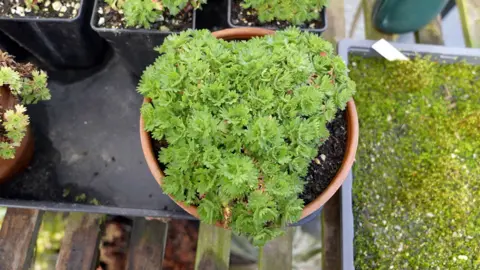 BBC/Gwyndaf Hughes
BBC/Gwyndaf HughesA plant that was vanished in the wild has actually been reestablished to the UK landmass. We can not inform you the specific area – it’s a secret to maintain it risk-free. It’s simply a little plant, however one in 6 types in the UK is jeopardized, so you need to begin someplace. We existed when leading green thumb Robbie Blackhall-Miles returned it to its indigenous dirt.
I initially fulfilled Robbie at an endangered plant baby room– situated in a peaceful location ofNorth Wales
What he maintains there is so important that he can not also pay for to guarantee it.
He informed me to be cautious concerning just how much we reveal– there is still a rewarding market for unusual and unique plants, which are typically gathered unlawfully and typically bring hundreds of extra pounds.
Pointing to a pot, he claims, “There are just 30 such trees left worldwide.”
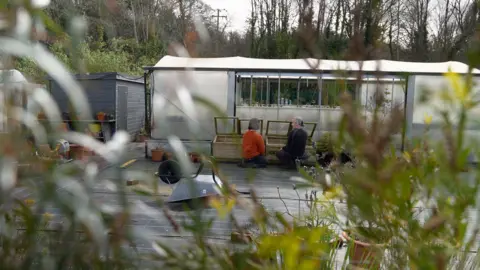 BBC/Gwyndaf Hughes
BBC/Gwyndaf HughesAll around us are trays of plants, bags of dirt on the flooring, plants expanding and growing. Thermometers hang from the ceiling to inspect that the plants are not as well warm, as well chilly or as well completely dry.
Robbie is high and sports, he chats enthusiastically. When I began investigating this tale, Robbie’s name maintained showing up over and over in the documents of organic cultures – there are really couple of individuals in Britain that understand a lot concerning plants.
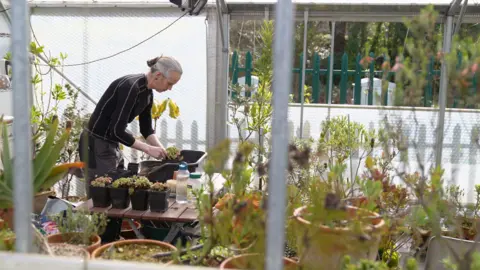 BBC/Gwyndaf Hughes
BBC/Gwyndaf HughesHe entered into anatomy after a youth interest for conserving pets and a job functioning as a version. He currently helps a preservation organisation called Plantlife.
“If you consider British biodiversity like a challenge– all the items are truly vital, however some are missing out on,” he claims.
Working carefully with the National Trust and Natural Resources Wales, they intend to bring back that biodiversity by reestablishing the vanished Rosy Saxifrage– a plant they call the Mountain Jewel– to Eryri, or Snowdonia.
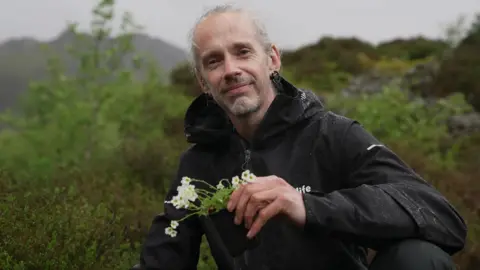 BBC/Gwandaff Hughes
BBC/Gwandaff HughesThe last time pink saxifrage was seen in the wild in Britain remained in 1962, someplace in the Cwm Idwal nature get atEryri
I intended to see the location– so Robbie and National Trust ranger Rhys Weldon-Roberts took me and my coworker toCwm Idawal
We adhered to a course winding around the lake to a place called “Twal Du” or “Devil’s Kitchen” in English.
Robbie quit every couple of actions to mention unusual plants that had actually handled to make it through.
Incidentally, I had actually been right here previously walking. While having a hard time to climb up a hole in between the hills, I was entirely not aware of the valuable types living under the rocks.
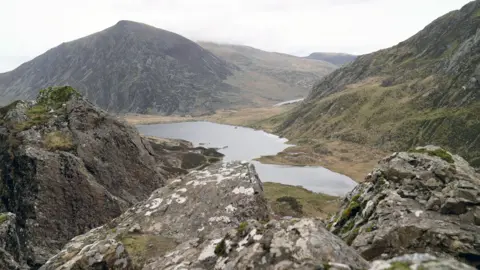 BBC/Gwyndaf Hughes
BBC/Gwyndaf HughesThe pink saxifrage has actually been stated vanished, however Robbie, a knowledgeable mountain climber, double-checked anyhow. “I’ve been trying to find it for 6 summer seasons, climbing up ropes, simply in situation we’re incorrect,” he claims, indicating the high high cliffs.
“The pink saxifrage is one of the most typical indigenous plant located in Britain,” claims Robbie, remaining on a rock and smoothly watching out over the significant landscape.
It belongs to a family members of hill plants that remained to prosper also after north Britain was iced up over throughout the glacial period. When the glaciers thawed, the saxifrage stayed and remained to prosper in the hill setting.
But their fragile type and quite blossoms at some point made them a magnet for plant collection agencies– particularly the Victorians, that selected them for personal collections.
Subsequent environment loss and inadequately handled grazing in Eriwari came to be the last fatality knell for this plant.
Numbers decreased drastically, till it vanished from the UK landmass.
The following component of the tale is mythology– in 1962 an instructor and preservationist called Dick Roberts remained in Cwm Idawal on an institution journey.
He grabbed an item of a plant that had actually wandered along the course and placed it in his pocket. He really did not understand what it was, so he took it home and expanded it in his yard.
All the pink saxifrage we have in the UK landmass currently is many thanks to that little plant – it conserved the plant for future generations. About a years back Robbie was provided a reducing to take care of.
” I’m really pleased to be collaborating with a component of Dick Roberts’ heritage,” he claims.
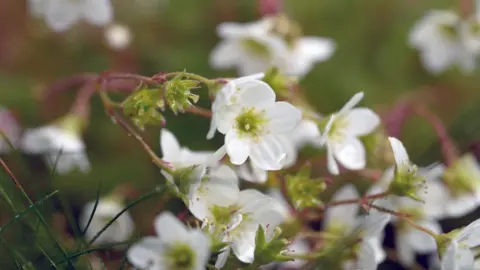 BBC/Gwyndaf Hughes
BBC/Gwyndaf HughesIt is really uncommon to reestablish a varieties with a hereditary offspring of the initial types.
Most typically, associated types are made use of; for instance, the European beaver was made use of to reestablish beavers toBritain
But Robbie holds it in his hands and claims: “This is from cuttings upon cuttings of that initial Welsh product.”
Nature in Britain has actually transformed drastically in the years considering that Dick Roberts stayed inEryri
One in 6 types goes to danger of termination. In the last 30-40 years we have actually shed 19% of monitored types, making the UK among one of the most nature-depleted nations in the world.
I welcomed Julia Jones, Professor of Conservation at Bangor University, to Cwm Idwal and asked her just how much of a distinction reviving this little plant might make.
The fact is that this alone will certainly not change Britain’s nature– preservation is as well intricate and needs several points, consisting of securing environments from environment adjustment, air pollution and extensive land usage.
But Professor Jones claims the reintroduction is a significant campaign and “a pointer of just how much we have actually shed.”
High- account plant reintroductions are unusual– the majority of job has to do with bringing pets back. The most well-known in Britain are possibly the beaver or the white-tailed sea eagle– charming types that normally obtain individuals a lot more thrilled than plants.
Some researchers speak about “plant loss of sight”– the concept that individuals do not see the plants around them as vital living points– rather, they resemble wallpaper in our native environment, despite the fact that they do a whole lot for our environment and have a duty in medication manufacturing.
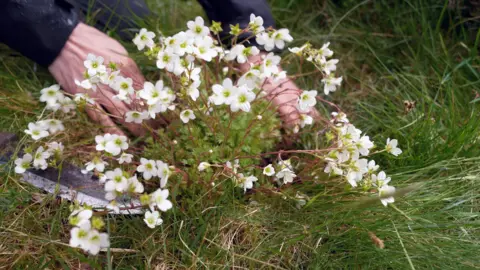 BBC/Gwyndaf Hughes
BBC/Gwyndaf HughesFinally, a couple of days back, the minute got here for which we had actually been awaiting 10 years.
At a secret area in Eriree, a couple of individuals collected in the rainfall, consisting of ranger Rhys Weldon-Roberts He would certainly maintain a careful eye on the plant, cautious of collection agencies.
“Hopefully the day will certainly come when it’s no more a rarity and every person that comes right here will certainly have the ability to value it,” he claims.
For Robbie Blackhall-Miles, that will certainly remain to watch on the saxifrage, it’s a huge minute.
After 60 years of farming, can it make it through outside?
He lugs baskets of plants from his auto.
It has actually transformed a whole lot considering that I last saw it– lengthy branches grow from the thick fallen leaves, expanding in the direction of a white blossom with 5 flowers.
” I enjoy these blossoms– they beam at you,” claims Robbie.
After going across the river, Robbie flexes down, and peels off away the flexible turf and dirt. While excavating, he locates a rock: “It’s penalty – saxifrage suggests rock breaker in Latin.”
After a couple of mins, the little hill treasures go back to their initial dirt.
Robbie is plainly enthusiastic. In his home nation, presenting something brand-new to his preferred landscape is one of the most vital minute of his job.
“In Welsh we have a remarkable word recuperation which suggests remediation or reinstatement,” he includes. “I am definitely delighted.”
Additional coverage by Gwyndaf Hughes




